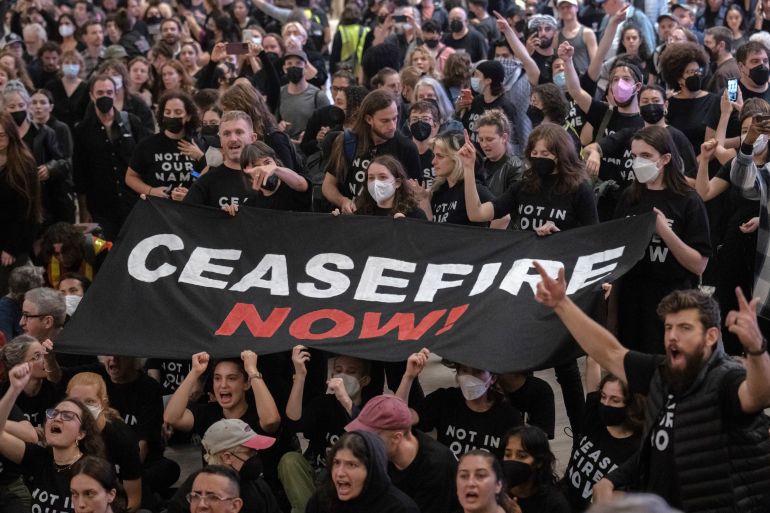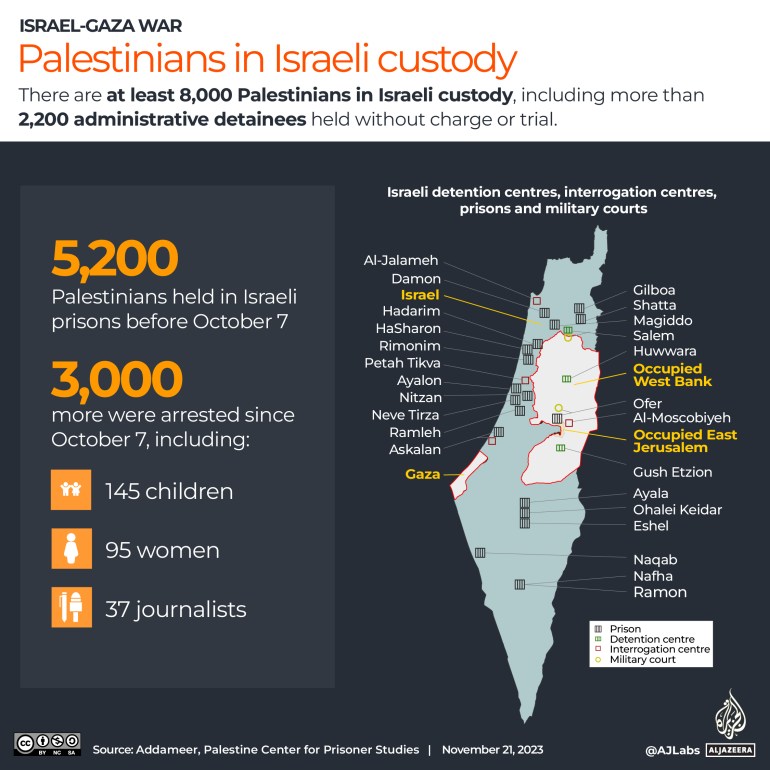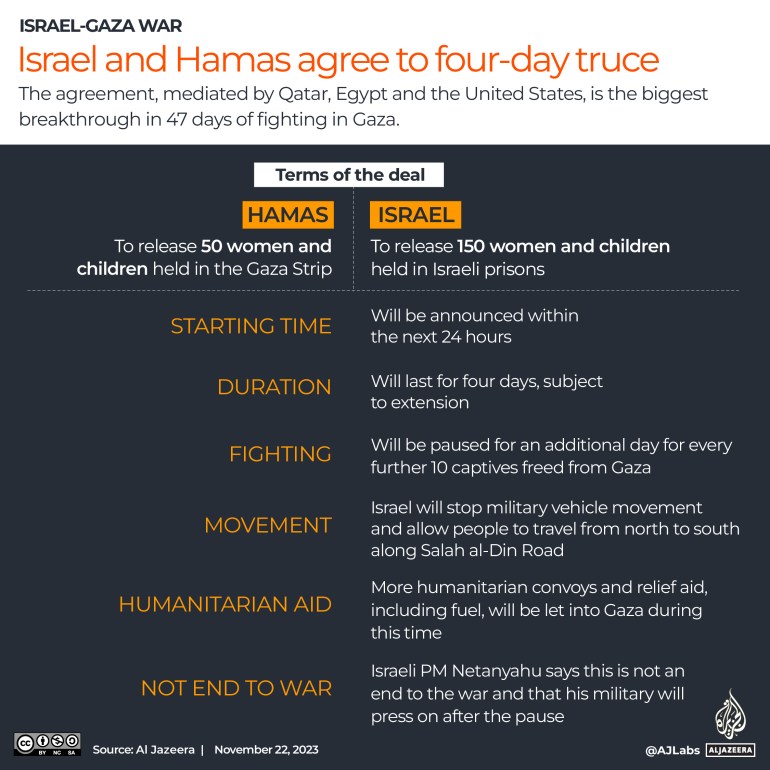Israel-Hamas truce deal: All that you need to know
The two sides have agreed to a four-day pause in fighting, but Israel has made it clear that it is not ending the war.

After more than six weeks of fighting that has destroyed extensive areas of Gaza and killed thousands, Israel and Palestinian armed group Hamas have agreed to a four-day truce.
Since October 7, when Hamas fighters attacked southern Israel and killed 1,200 people, the Israeli army has been relentlessly bombarding Gaza with air and ground attacks, killing more than 14,000 Palestinians, mostly women and children.
Keep reading
list of 2 itemsHamas, Israel leaders suggest deal is ‘close’ on captives, Gaza truce
An estimated 1.7 million Palestinians have been displaced and forced by the Israeli army to flee to the southern areas of the Strip.
Here’s what you need to know about the truce deal:
What have Israel and Hamas agreed to?
- Both sides have agreed to a four-day pause in fighting.
- In exchange, Hamas has agreed to release 50 civilian women and children out of the 237 captives abducted since October 7.
- As part of the deal, Israel has agreed to release 150 Palestinian women and children from its prisons.
- Qatar has said that the deal would allow an increase in the flow of humanitarian aid into Gaza.
- Israel said it was willing to extend the pause beyond the four-day period, adding a day for every 10 additional hostages released by Hamas.
- It is unclear whether Israel will release additional Palestinian prisoners if the truce is extended.
How did the truce happen?
The agreement was mediated by Qatar, which had been leading negotiations between Israel and Hamas, while coordinating with other regional and global powers, including the United States and Egypt.
US President Joe Biden thanked Qatar’s Emir Sheikh Tamim bin Hamad Al Thani and President Abdel Fattah el-Sisi of Egypt for their role in the breakthrough.
Israeli Prime Minister Benjamin Netanyahu said that he had leaned on Biden to secure a better deal for Israel, and thanked the US president for his efforts.
Netanyahu also made it clear that the country was not ending its war on Gaza and that the stopping of fighting was only temporary.
The State of Qatar announces that a humanitarian pause has been agreed in Gaza#MOFAQatar pic.twitter.com/5qqjSjvt4X
— Ministry of Foreign Affairs – Qatar (@MofaQatar_EN) November 22, 2023
Is the truce already in force?
No. As of Wednesday morning, fighting continued between the two sides. Qatar said that the start time of the pause would be declared within 24 hours.
How did Israel come to approve the deal?
After weeks of hectic negotiations and multiple instances when a deal appeared on the horizon before falling apart, Netanyahu called a meeting of his cabinet on Tuesday night.
The Israeli prime minister presented the proposed deal to his ministers, and only three members of his cabinet opposed it — National Security Minister Itamar Ben-Gvir and two other members of his far-right political party.
![]()
What happens if either side breaks the truce?
Neither side is expected to hold back on restarting hostilities if the other breaks — or is perceived to have broken — any of the terms of the agreement.
Israel is not withdrawing its soldiers, tanks, armoured vehicles and other military infrastructure from Gaza, which it entered late in October in a ground offensive.
What do we know about the captives held by Hamas?
- Israel says at least 237 people were captured during the October 7 attacks by Hamas.
- They include 33 children, according to the Israeli government.
- The captives come from more than 40 countries; including at least 20 Thai farm workers.
- Some of the captives are Israeli soldiers. One Israeli soldier was already rescued.
- Hamas has released four people already – two Israeli citizens and two US citizens.
- Hamas has said 50 captives have been killed in Israeli air raids on the Gaza Strip.
- Israel also said the bodies of two female captives were recovered near the al-Shifa Hospital complex.
- Biden said in a statement that he expects Americans to be included in the 50 captives released under the deal.
What do we know about Palestinians in Israeli prisons?
- Before October 7, there were about 5,200 Palestinians in Israeli prisons.
- Since then, Israeli forces have arrested at least 3,000 more Palestinians during daily raids across the occupied West Bank and occupied East Jerusalem.
- At least 145 of them are children, according to rights and monitoring groups.
- At least 95 are women.
- At least 37 are journalists.

What was the timeline of the deal?
- On November 15, reports began emerging of Qatari mediators closing in on an agreement between Israel and Hamas for the release of 50 captives in Gaza in exchange for a three-day pause.
- On Sunday, Qatar’s Prime Minister Sheikh Mohammed bin Abdulrahman Al Thani said that “minor” and “more logistical” challenges remain with negotiations of the deal, which were “going through ups and downs”.
- Israel’s Channel 12 reported that the country’s war cabinet met on Sunday and discussed that it was ready to move forward with the negotiations and tell Qatar it was ready to reach an agreement.
- On Monday, US President Joe Biden said he believed a deal to free the captives was close. The White House clarified that terms had not been finalised.
- The same day, Red Cross President Mirjana Spoljaric met with Hamas leader Ismail Haniyeh in Doha and had separate talks with Qatari authorities.
- On Tuesday, Hamas official Izzat al-Rishq told Al Jazeera that a deal had been in talks for weeks but Netanyahu was stalling. He added that all brigades of the Palestinian resistance agreed on the deal via phone call and that Hamas had delivered its response to Qatari negotiators.
- On Wednesday morning, the Israeli cabinet backed the agreement after talks on the Qatar-mediated deal.
- Later on Wednesday morning, Israel and Hamas independently confirmed the pause in fighting.
What’s next?
Israel’s parliament has 24 hours to appeal against the truce agreement with its High Court. The first exchange of captives and prisoners is expected to take place after that period, on Thursday or Friday.
James Dorsey, senior fellow at the National University of Singapore’s Middle East Institute, told Al Jazeera that Israel’s temporary truce with Hamas is just a first step in difficult negotiations ahead, with a lasting peace in Gaza still far off.
“What this [deal] tells you is how difficult things are going to be going forward. Once you get to the question of releasing Israeli military personnel held captive by Hamas these negotiations are going to become much more difficult.
“My sense is that Israeli Prime Minister Netanyahu was caught in a bind. On the one hand domestic pressure – which wants the hostages released and wants them released now – and, on the other hand, US pressure to allow for a truce.”
